Close Encounters: Commercial Shipping and You
Foundation Findings #10 - March 1991
A clear, moonlit night with 15-knot winds provided the ideal setting for the annual August Night Regatta, a 40-mile sailboat race across and down the Chesapeake Bay.
The skipper and crew had grown weary from an all-nighter of fierce competition. Those still awake strained to make out the next mark, a four-second red flasher that should be about a mile and a half ahead.
Suddenly, the air was shattered by five deafening blasts from a horn above and behind, sounding an urgent, repeated danger signal.
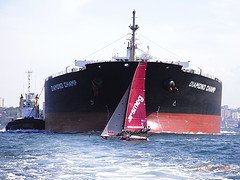
The skipper quickly turned to look astern, shocked to see a mammoth cargo ship bearing down on his stem, bright lights high above a massive dark shadow, approaching rapidly on an apparent collision course from off the port quarter.
Stunned, the skipper was at first unsure of what to do. But in a moment he gathered his wits and ordered the crew to come about to starboard. The sailboat veered off, safely out of the path of the freighter, but with little room to spare. The anxious moment now passed, crew and skipper breathed a collective sigh of relief.
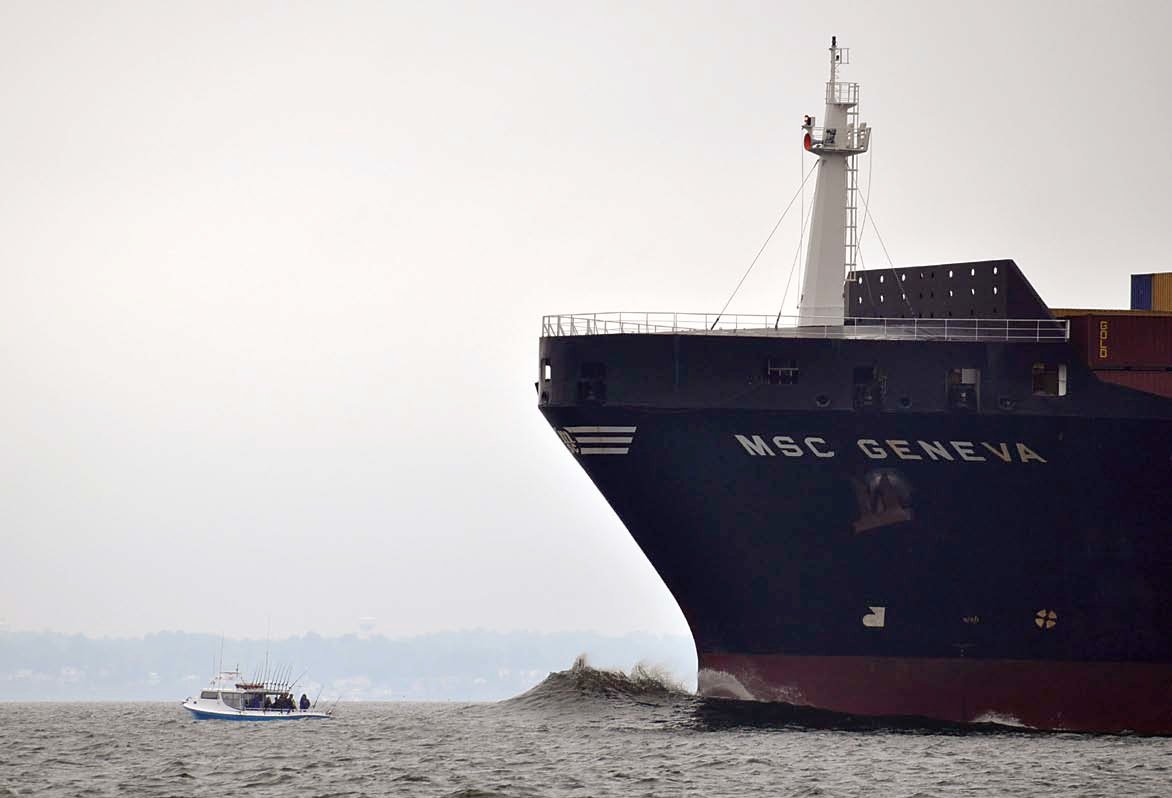
Close encounters between commercial ships and recreational boats is a scenario repeated over and over throughout the United States, wherever large commercial vessels share the waterways with smaller recreational craft. These encounters occur with increasing frequency as waterfronts are developed to provide water access to more recreational boaters every year. The commercial traffic is here to stay. Ships, supertankers, tugboats towing or pushing barges, and other commercial vessels are a thriving part of the American economy-delivering goods, employing labor, and contributing to the total commercial and industrial output of our nation. And since our great commercial hubs are also dense population centers, recreational boaters and commercial operators have no choice but to learn to live together.
Commercial Shipping and You
Foundation staff wanted to learn more about these encounters with commercial vessels and the constraints under which big ships operate, so that we could offer some sound advice on how recreational boaters can safely share the waterways with commercial boat traffic. To get first-hand insight from the pilots who command big ships, we arranged to make two passages aboard two different vessels on the Chesapeake Bay. Our daytime voyage took place aboard the Addiriyah, a 600' Saudi-flagged container ship, traveling from the Chesapeake and Delaware Canal down the bay to Baltimore. Our nighttime passage was the reverse trip, north from Baltimore to the C&D canal, aboard the 502' Pakistani ship Hyderabad. A 25' pilot boat took us with the pilot out to ship, which was already moving at five knots. The helmsman expertly guided the pilot boat alongside the ship and kept an even pace with the larger vessel as we climbed, one hand at a time and holding on tightly, the 30' rope ladder to the ship's deck. From there we dashed up five flights of stairs to the bridge, as pilots quickly take command once aboard the ship. On the bridge we were greeted by the captain, who is in charge of the vessel at all times during the passage, except when in restricted waters where he turns control of the ship over to the pilot. Use of binoculars or range finders will help you ascertain exactly where ship is headed.A rapid exchange of critical information between the pilot and the captain took place, including a description of all area boat traffic, weather and water conditions, and a verbal checklist to make sure all the ship's systems were functioning properly. Also present on the bridge was the helmsman, who takes orders on rudder position, degree headings, and speed from the pilot; a first mate/navigator; and a master who served as an additional lookout. At this time, the captain generally leaves the pilot house to retire.
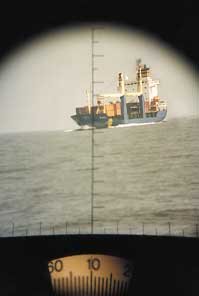
As we traveled down the Bay, the pilot continuously scanned the water in front of and around the ship, and kept up a running series of course and speed change commands to the helmsman, who repeats each command before executing it. While keeping an ear to the radio at all times, every few minutes or so the pilot stepped out to the wings on either side of the bridge to observe traffic up and down the entire length of the ship, check the gyrocompass, and scan the horizon with binoculars. The first mate alternated between chart and navigational duties, checking the radar, and keeping alert for changes in traffic around the ship.
The pilot kept us informed of what conditions he was considering at any given time, provided detailed descriptions of complex hydrodynamic and other physical factors that dictate the ship's movement, and explained how he copes with the near-constant ebb and flow of recreational traffic around the moving ship.
Getting in tight quarters with a big ship can be quite unnerving. Your best defense is a good offense. Face it: In a confrontation with any massive, swiftly moving vessel literally thousands of times your size, you won't win. The best way to avoid such nettlesome confrontations is to be aware of the specific areas where ships, tugs, and barges operate, be on the lookout for such traffic, be able to identify what type of commercial vessel you are seeing, anticipate its movements in advance, and know how to communicate with the ships' pilots so you can steer clear of each other and avoid creating an anxious and potentially dangerous situation.
Even though commercial pilots run a much lower risk of personal injury than pleasure boaters, they find encounters with small boats equally nerve-wracking. Pilots do everything within their power to avoid collisions and near misses. Their professional licenses are at stake, and they risk huge lawsuits and liability claims with every passage. A full-fledged pilot receives as much training as a medical doctor: four years in a maritime college, followed by three to six years at sea as a Senior Officer. after which he serves two years as an apprentice, out on the water every other day making literally hundreds of trips under different pilots. Then he can sit for the federal and state licensing exam, and receive a limited license (for operating small ships) . After operating three more years under the limited license, he can become a fully licensed, unlimited pilot.
Ships are among the biggest and most powerful manmade machines on earth. Today's modem supertankers weigh in at 80,000-100,000 tons, can top 1,000' in length (more than three football fields!), have beams of 100' and drafts over 40'. They can move at 20 knots or more in open ocean. But their maneuverability, stopping distance, turning radius, and visibility are severely restricted by their size and by the channels in which they operate. With these limitations, pilots must carefully consider each maneuver in terms of the waterway and other boat traffic well ahead. Plans to slow and stop are made literally miles in advance. Commercial pilots are in constant radio communication, broadcasting their position, course and speed, exchanging information about the presence and movement of small craft, and any other information that ensures safe passage.

Visibility is a primary limitation on big ships. In fact, on the 600' Addiriyah, with its bridge 100' above the water, we lost sight of a small powerboat crossing the channel in front of us when we were fully 3/8-mile away. On larger ships, a pilot often loses sight of a small boat when it is still 1/2-mile or more distant. The recreational boat skipper's perception of the distance between his boat and potential danger is completely different than the pilot's perspective. Looking up from the water level a half-mile away, the skipper can clearly see the ship's bridge, assumes the pilot can see him, and that he has plenty of room.
Big ships are also restricted in their maneuverability and by water depth. A ship's ability to maneuver and the distance required to turn are functions of speed. The effects of shallow water can be dramatic as well. Turning diameter, or the distance required to turn the ship, can double in shallow water. The ability to steer the ship depends on the force of water being pushed against the rudder. The faster the ship moves, the more maneuverable it is. As it slows, steering ability is reduced. When the propeller is stopped completely, steering ability is dramatically reduced. When the ship has no more way on, it is effectively out of control. "And if you have to go into reverse," warns one pilot, "you might as well punt, because you just don't know what the ship will do."
There is another burden placed on pilots today. At an average operating cost of between $15,000 and $40,000 a day depending on size, ships must economize wherever possible. This can result in a minimum, skeleton crew operating a ship. Communication aboard ships can also be a problem on foreign ships where crews have limited English-speaking skills.
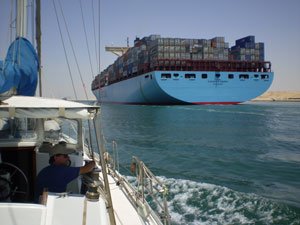
With all of these limitations to factor into a constantly changing and complex traffic equation, pilots of big ships canuse all the help they can get, especially in narrow channels with heavy boat traffic. You can avoid "close encounters of the dangerous kind" by following the collision avoidance practices below whenever you are operating in and around big ships.
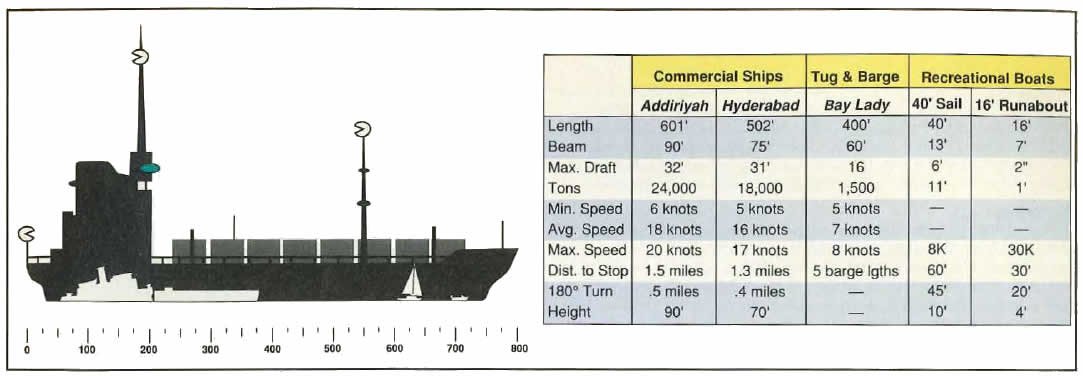
Your First Defense: Be Alert
The best way to learn when and how to avoid big ships is by paying constant attention, and like everything else on a boat, with practice. You must obey the same rules as the ship's pilot when it comes to keeping a proper lookout. Look behind you frequently.
Watch for ship and barge traffic, and don't underestimate the speed of large ships. They may appear cumbersome and slow-moving, but a ship steaming at 20 knots is actually moving 34' per second. Even if you're well away from the channel, keep a good lookout for tugs and barges, which frequently operate outside the channel.
Think of a ship channel as a major interstate highway. Interstates are designed for rapid, unimpeded transit by massive trucks and long distance, express travelers. Superhighways were not designed for slower-moving pedestrians, but sometimes they are there. Just as everyone who uses the highway has certain rights, it's prudent to know when to exercise those rights. A pedestrian wouldn't stop to picnic in the middle of the freeway. Likewise, a ship channel is no place to anchor for cocktails or an afternoon of fishing. Don't put yourself in a position where you can't get out of the way of a big ship.
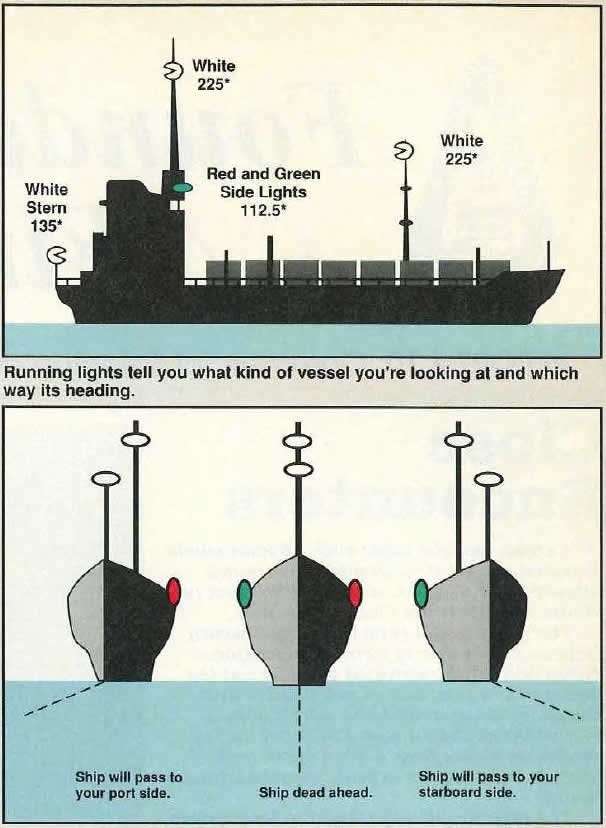
Consulting a chart can be a reliable way to determine commercial traffic patterns in the area where you boat. Shipping lanes are shown as a path of dashed lines indicating the outer sides of the channel, marked off at intervals with pairs of channel marker buoys. Sometimes the routes are clearly set off with blue or magenta. But charts are not crystal clear. Study the chart; in some cases only narrow channels are marked off, so in wide, open expanses you have to identify the channel yourself by following the pairs of buoys and reading the depths. If you use one of the chart books that provide bearing lines to help you set your course, check to see if they lead directly up the center of the shipping channel, or across it, and be on the lookout for commercial traffic at those points. Sometimes water depths, coastal configurations, and other hazards will prevent you from staying out of the channel. But in most U.S. waters there is enough room for pleasure boats to maneuver comfortably outside the ship channel.
Steer Clear
The International and Inland COLREGS (Collision Regulations) specify that vessels restricted by channel depth or maneuverability have the right of way. So give them room. If you must cross the channel, cross quickly. If you're near the channel and you see a ship approaching, your best move is to make a highly visible, deliberate maneuver early on to indicate avoidance. The key word here is early. Move out of the path of the ship when it's still far away, and maintain your course once you have made the change. The pilot is keeping a constant, careful vigil. He will see your move, and he'll know that you've seen him coming and intend to s tay out of his path.
If the pilot sees the potential for a collision developing, he will sound five short blasts on the ship's horn to warn boats in the vicinity of his approach. Five short blasts means "danger." The message is clear: Get out of the way!
Just as recreational boats are responsible for their wake and any damage or injury they cause, commercial pilots are also responsible for their ship's wake. The pilot will begin slowing the ship miles before he approaches congested waters or narrow channels. But you should protect yourself by being mindful of the ship's wake and its potential for damage and injury. If you are near the shoreline or docked when you see a big ship approaching, remember that in addition to the visible, curling bow wave from the front of the ship, you will feel the effects of the large, evenly spaced swells of the stem wake, traveling at the same speed as the s hip, long after the ship is safely passed.
Identify What You See
At night, running lights on large ships are quite visible. but they can be very confusing. Because it is dark, you may have difficulty determining exactly where the shipping channel lies, and be uncertain about the s hip's direction. Seventy-five percent of shipping traffic occurs at night. if you boat at night, it's absolutely essential to learn the different light configurations that tell you what kind of vessel you're looking at, which way it's heading, and if it's a tug, whether it is towing or pushing a barge ahead.
In addition to the red port and green starboard running lights that tell you which way a ship is heading at night, two bright white range lights are displayed fore and aft. The white light placed higher off the water is always at the stem. To determine whether you're in the path of a ship, look at the way the range lights line up. If one white light is directly above the other white range light, you are dead ahead of the ship. Move out of the way fast. If you're sailing, remember that the body of a big ship can steal your wind and prevent you from executing a maneuver you thought would take you clear. Take evasive action early-earlier than you think is necessary to be safe.
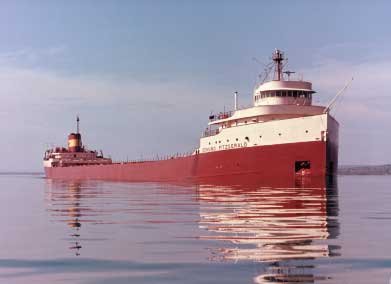
Tugs towing or pushing barges present a special hazard there are two vessels to contend with. If you spot a tugboat. Look carefully for a tow: either a long, flat barge being pushed in front or along side of the tug, or being pulled behind on a long hawser, or tow rope. Barges are particularly difficult to see at night, when their long, low profiles may appear as dark shadows far ahead or astern of the brightly lit tug. They may not be visible at all. A number of recreational boating deaths have occurred when small boats running between tugs towing barges were run down by the barge or fouled in the hawser.
Be Seen
Use your running lights at night. Make sure they are not obscured by sails, flags, swim ladders, or dinghies. (See Foundation Findings Report #9: Navigation Lights.) Don't try to conserve energy by leaving your running lights off until you spot a ship, and then flick them on. Your perspective of a safe distance is not the same as the pilot's; you may already be out of his line of vision when you turn on your lights and he'll never even know you're there.
The higher your running lights are mounted, the more visible you'll be from the bridge. Sailboats can become "invisible" at night when red and green running lights pop in and out of view as the boat heels, when the boat tacks or jibes, or when the lights are obscured by motion through waves. If you sail around big ships at night, consider installing a tri-color running light at the masthead for maximum visibility.
Sailboats frequently shine a bright light on the sails to indicate their position to approaching pilots. Powerboats, too, can use a spotlight, strobe, a white flare, or flashbulb to make themselves visible. The pilot is keeping a good lookout around and ahead of the ship, and he will see it.
Radar
Radar is an essential tool for pilots on the bridge of big ships, but it has its limitations. Radar is useful in pinpointing and tracking a single target, especially in foul weather or poor visibility. But in a congested waterway with many boats, the ability to plot multiple radar targets is limited. Pilots must then resort more to visual means to track the movements of many boats at once. Radar reflectors, correctly mounted, are an asset for recreational boats, and can assist big ships in avoiding you. But you should not rely solely on your radar reflector. Keeping a proper lookout at all times is still your most effective defense.

The two most critical times to take defensive action are in rain squalls and in fog. Heavy rains severely affect the ship's radar scope with "rain clutter," thousands of tiny white dots that can literally "white out" the radar scope.
Fog is frightening, and it is easy to lose your bearings. If you don't have to travel in fog, don't. If you have to be out there, and you can avoid crossing a ship channel, avoid it. Not only is visibility severely limited, but the direction and intensity of sound are deceptive. It will be difficult to determine correctly the position and bearing of an approaching ship. Stop your boat periodically. Turn off your engine so you can hear and get your bearings. Use your sound signaling device at regular intervals as required.
VHF Radio
Your VHF radio is a very effective tool in ship confrontation avoidance. Whenever you are boating near shipping lanes, monitor VHF Channel 16 so that the pilot can communicate with you if necessary. You can also monitor VHF Channel 13. This channel is designated for bridge-to-bridge communications between pilots, watch officers, and tugboat captains to communicate among themselves the movement of vessels, hazardous conditions, and special situations developing ahead of the ship's passage.
If you want to be sure you've been seen, use VHF Channel 13 to make a short, simple call to the ship's bridge. Keep it brief and don't clutter the air waves. The pilot may have other duties that demand his immediate attention. Don't bother calling the bridge if you are one of dozens of recreational vessels in the immediate vicinity of the ship; unless your boat's appearance is quite unique, the pilot will not be able to distinguish you from the other boats. Just steer clear.
Both recreational boaters and commercial craft share responsibility for avoiding each other. But a recreational boat is much easier to maneuver out of danger than a big ship or a tug-and-barge outfit. Do what the pilots do: keep a good lookout, steer clear, and let the pilot know your intentions. By staying out of harm's way, you protect your passengers and your property from a dangerous confrontation. And you eliminate one of the anxiety factors that can take the "pleasure" out of "pleasure boating."

